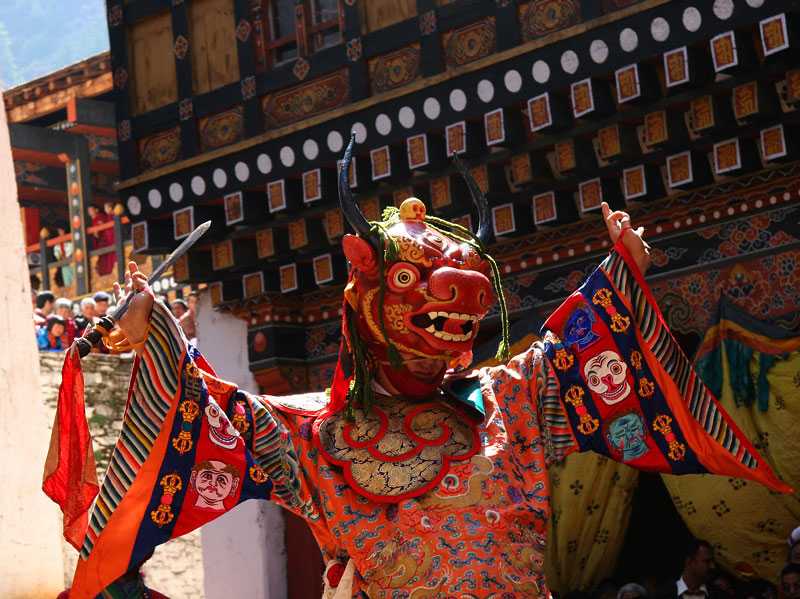- Dances, plays, songs and whatever you name - Paro Tshechu has it all.
- Monks and laymen wear silk costumes and perform sacred masked dances.
- Most dances have a story associated with them, which are depicted in the form of the performances.
- The theme of most of these spectacular dances is the victory of good over evil.
- They revolve around the visions and life words of Guru Rinpoche. His life story is depicted in the most beautiful way possible.
- Some of the most popular dances are Lords of the Cremation Grounds, Novel Men, Stag and Terrifying Deities.
- Many wind instruments, such as trumpets and flutes, are played, which fill the air with a sense of festivity and triumph.
- People seek blessings of Buddhist Gurus including Guru Rinpoche.
- Men and women are dressed in their finest clothes and have delicious Bhutanese cuisine packed with them in the bamboo lunchboxes.
- Everyone eats, and even the strangers come together as a family. No one feels left out here, and the locals tell the festival's history with unparalleled joy and enthusiasm.
The Last Day of Tshechu

Source
The fifth and the last day witnesses a huge amount of crowd and excitement. No matter what, people do not miss the last day's celebrations, especially in the early morning. The day begins with the unwinding of a Thangka of Guru Rinpoche on the wall of the fortress. It is considered the most auspicious ceremony. People's life sins are believed to be washed away by having a look at this auspicious thongdroel.
The ceremony takes place early in the morning and is followed by masked dances. Very significant masked dances take place on the last day of the tshechu. The eight manifestations of Guru Rinpoche are re-enacted on this day only, and this is a performance not to be missed for the world. It is colourful and vibrant and the entire atmosphere around you would be engrossed in the festival.
History of Tshechus

Source
The colourful tradition of tshechus began in Bumthang when Guru Padmasambhava helped to heal the king of the nation. Sindhu Raja, the then-king of Bhutan, was on the verge of death when Guru Padmasambhava, with his powers and belief, healed him. He performed a series of dance in Bumthang valley, which cured the ailment of the king.
After the king was healed, he helped Guru Padmasambhava in promoting Buddhism in Bhutan. That is when the first tshechu was held, where Dance of Eight Manifestations of Guru Rinpoche was performed.
How Paro Tshechu Began

Source
In 1644, the consecration of the Paro Dzong by Zhabdrung Ngawang Namgyal and Ponpo Rigzin Nyingpo was followed by a grand celebration in the form of masked dances and traditional songs. It came to be recognised as Paro Tshechu, and since then it is being celebrated every year with the utmost zeal and happiness.
Like most tshechus in Bhutan, Paro Tshechu lasts for five days, and the whole town participates in it. It is celebrated in the memory of Buddhist Saint Guru Rinpoche, who introduced Buddhism in Bhutan. He is referred to as the "Second Buddha," and people worship him with pure faith.
If you are going to attend Paro Tshechu, then you do not need any special permit for that. Just like locals, visitors are also allowed to enter. There is no entry fee as well. So, there are absolutely no formalities for attending the festival. A celebration of the very culture of Buddhism, Paro Tshechu is a lively festival whose roots are embedded deep in the town's history. Planning your trip around this time would make your journey thousand times more cherishable. So, if you want to live Paro, then experience Paro Tshechu.



Nice work la madam
ReplyDelete